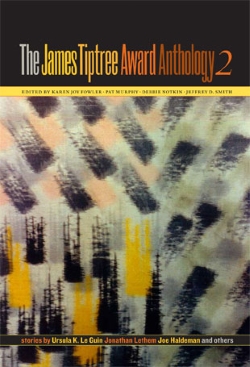Short fiction is—and has been for decades—a place for writers to experiment, express themselves, push the boundaries of genre and contemporary ideas. Not too dissimilar to novels, then. Gender has not fared poorly in this field, with short fiction examining the idea of the binary and what could lie beyond it.
At the forefront of consciously boundary-pushing work is the 1998 short story and Tiptree Award winner “Congenital Agenesis of Gender Ideation by K.N. Sirsi and Sandra Botkin” by Raphael Carter (published in Starlight 2, ed. Patrick Nielsen Hayden; reprinted in The James Tiptree Award Anthology 2, ed. Fowler et al), a fictional academic article about a phenomenon observed in a small number of individuals: the apparent inability to correctly perceive gender. Instead, their inability is to discern concepts as non-specific as “male” and “female.”![]()
“Not only did the twins correctly sort these photographs [of intersex people] from the male and female controls, they distinguished accurately between such different intersexual conditions as true hermaphroditism, gonadal agenesis, and male and female pseudohermaphroditism. … After some hesitation … they picked up the pile of control photographs and sorted them into a total of 22 categories.”
In this moment, the default falls away.
It is too easy for many people to ignore the existence of intersex people, but how can Sirsi and Botkin ignore the twins taking apart “male” and “female”?
Some of these categories are identified: 9 is women born with clitoromegaly, 22 is men born with hypospadias, conditions not discernable without close medical attention to the genitals. Other numbers remain unassociated with current medical knowledge of biological sex, though the scientists conducting the study start to wonder if they can see those categories—and what it means. The notion of innate perception of sex and gender is, in Carter’s story, both powerfully destabilising and potentially troubling.
“It’s easy to act as if nothing has changed,” Botkin muses. “Most days I don’t even think about the implications of what we’ve found. And then I’ll meet someone, and I’ll start thinking, ‘He’s a twelve. I know he’s a twelve. How do I know he’s a man?’”
As in Melissa Scott’s Shadow Man, the body binary of two is discarded—here, by the real breadth of intersex people. To talk of “male” and “female” is truly to over-simplify. The distinction between sex and gender is not so neatly distinguished in the story, but gender identity is possibly as discernable as different intersex people: “Category 6 comprised people with high scores on the Bem test of psychological androgyny.” What, though, of other measures of gender identity? What of fluidity?
Meanwhile, changes to the body are noted: “Perhaps most strikingly, categories 4 and 9 identified men and women who took artificial sex hormones rather than producing them naturally”—here for reasons of hysterectomy and similar situations, rather than transition, but the potential for trans people to be correctly identified is present.
The story would strongly benefit from it being more than potential, from explicitly addressing the categories that might include pre-transition trans people, trans people on hormones, trans people pre- and post-surgery/ies, non-binary trans people as well as those who are firmly male or female. Perhaps these are the hitherto unidentified categories.
The main question raised by “Congenital Agenesis of Gender Ideation by K.N. Sirsi and Sandra Botkin”—what does it mean for there to exist the innate ability to identify sex/gender?—is unanswered. Wise. What it takes as a certainty is that this innate ability discerns a multiplicity. Reality is post-binary. What it leaves unanswered is the place of non-binary and trans experiences, and it is this that troubles me about the notion of innate identification. If it is innate, it must be 100% inclusive, or real people’s existence is erased. What would that look like? Gender systems vary across cultures in contemporary Earth—what will the future of gender look like? The future of bodies? Would innate ability adapt to new experiences or pre-empt every possibility? What would happen if this ability was engineered to be more widespread?
I suspect the twins need a lot more numbers.
These questions reach beyond the story, but it pre-empts them: it leaves its own question unanswered because it can’t be answered, not decisively. The implications are vast, thorny—liberating?
First we need to accept the reality.
Alex Dally MacFarlane is a writer, editor and historian. Her science fiction has appeared (or is forthcoming) in Clarkesworld, Interfictions Online, Gigantic Worlds, Solaris Rising 3 and The Year’s Best Science Fiction & Fantasy: 2014. She is the editor of Aliens: Recent Encounters (2013) and The Mammoth Book of SF Stories by Women (forthcoming in late 2014).










